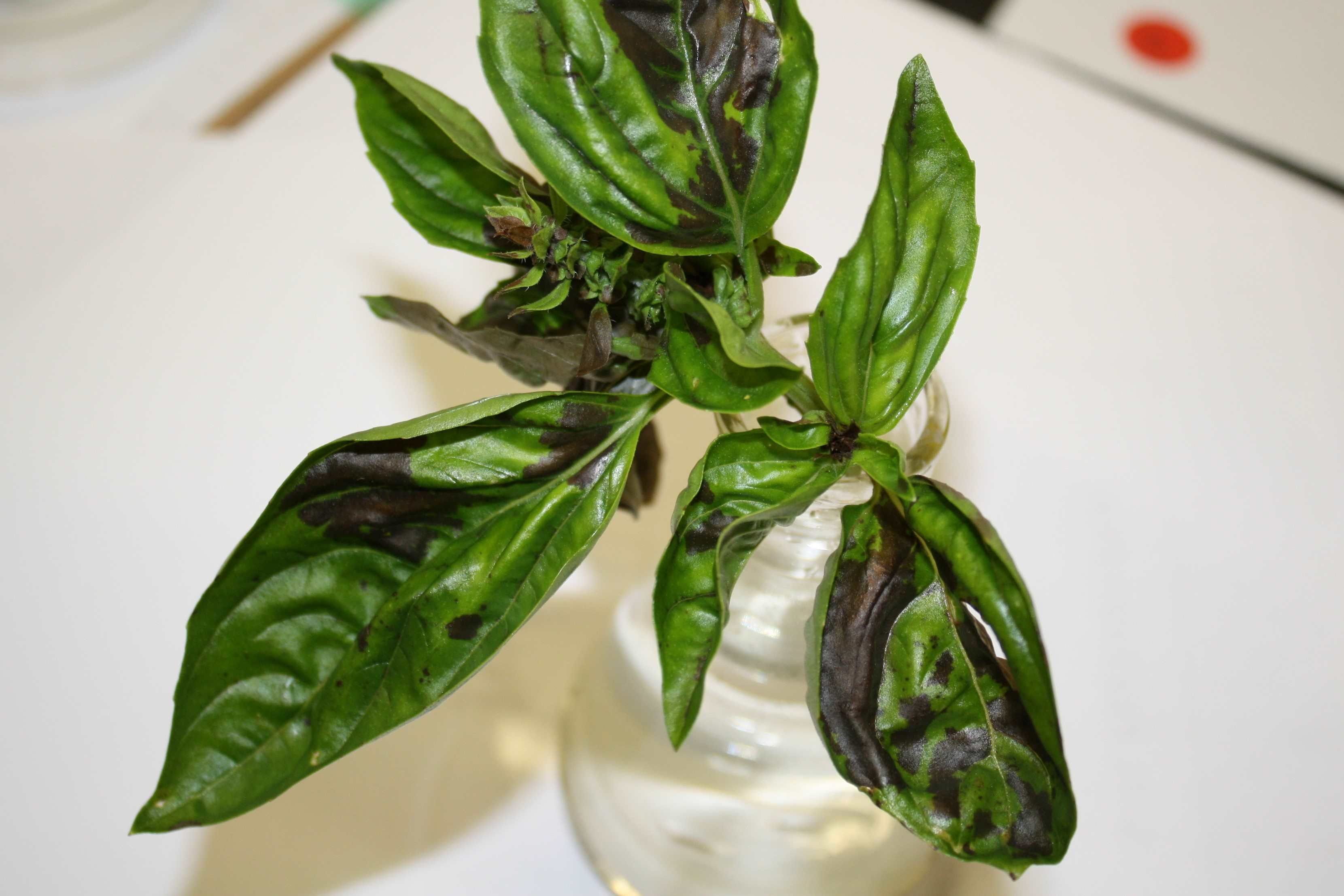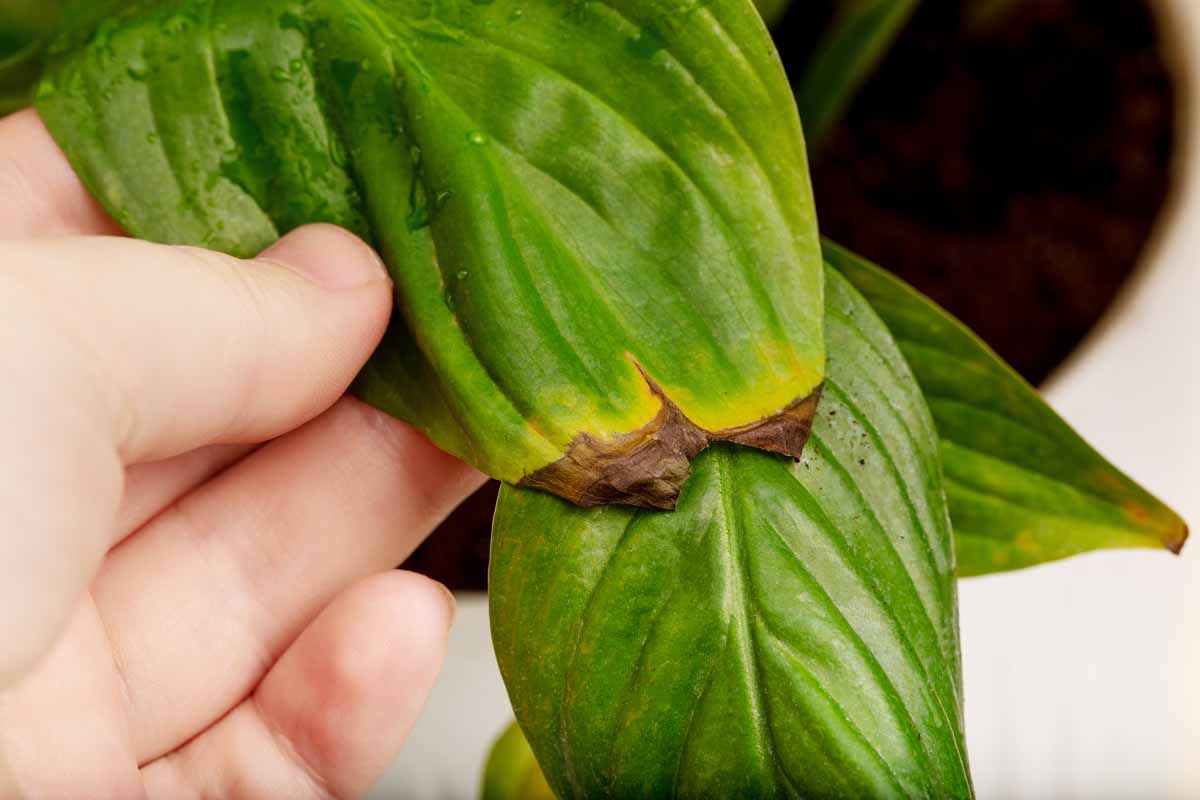Home>Science>The Surprising Reason Why Basil Leaves Develop Mysterious Black Spots


Science
The Surprising Reason Why Basil Leaves Develop Mysterious Black Spots
Modified: February 19, 2024
Uncover the scientific explanation behind the enigmatic black spots that appear on basil leaves. Delve into the intriguing world of plant science and discover the surprising reasons behind this phenomenon.
(Many of the links in this article redirect to a specific reviewed product. Your purchase of these products through affiliate links helps to generate commission for Noodls.com, at no extra cost. Learn more)
Table of Contents
Introduction
Basil, with its vibrant green leaves and distinctive aroma, is a beloved herb in culinary and medicinal practices. Whether it's used to infuse flavor into pasta sauces, garnish a Caprese salad, or concoct a soothing herbal tea, basil holds a revered place in kitchens and gardens around the world. However, despite its popularity, basil leaves are susceptible to a puzzling phenomenon that has left many gardeners and enthusiasts scratching their heads: the development of mysterious black spots.
These enigmatic blemishes, often appearing as small, irregularly shaped patches on the basil leaves, can be a cause of concern for those who cherish their basil plants. While basil is generally a resilient herb, the emergence of these black spots can be disconcerting, prompting questions about their origin and potential impact on the plant's health.
In this article, we will embark on a fascinating journey to unravel the mystery behind these peculiar black spots on basil leaves. By delving into the intricate world of basil plants and exploring the underlying factors contributing to this phenomenon, we aim to shed light on the surprising reason behind the development of these mysterious blemishes. Moreover, we will equip you with valuable insights on how to prevent and manage black spots, empowering you to nurture thriving basil plants in your own garden.
Join us as we delve into the captivating realm of basil leaves, uncovering the secrets behind their intriguing black spots and discovering the measures to cultivate healthy, vibrant basil plants.
Understanding Basil Leaves
Basil, scientifically known as Ocimum basilicum, is a member of the mint family, renowned for its aromatic leaves and diverse culinary and medicinal applications. This herb is characterized by its glossy, oval-shaped leaves that emit a delightful fragrance, making it a prized addition to various cuisines worldwide. Basil leaves come in different varieties, each possessing unique flavor profiles, ranging from the sweet and mild Genovese basil to the robust and spicy Thai basil.
From a botanical perspective, basil leaves play a pivotal role in the plant's life cycle. They are integral in the process of photosynthesis, where the leaves harness sunlight to convert carbon dioxide and water into energy-rich sugars, sustaining the plant's growth and vitality. Additionally, basil leaves serve as a means of transpiration, facilitating the exchange of gases with the surrounding environment and helping to regulate the plant's internal temperature.
Furthermore, basil leaves boast an array of chemical compounds, including essential oils such as eugenol, linalool, and estragole, which contribute to their distinct aroma and flavor. These compounds also harbor potential health benefits, as basil has been traditionally used in herbal medicine to alleviate digestive discomfort, reduce inflammation, and exhibit antimicrobial properties.
In the context of cultivation, understanding the characteristics of basil leaves is essential for maintaining the health and vigor of the plant. Factors such as leaf color, texture, and overall appearance can provide valuable insights into the plant's well-being, signaling potential issues such as nutrient deficiencies, pest infestations, or environmental stressors.
Moreover, recognizing the normal growth patterns and variations in basil leaves is crucial for distinguishing anomalies such as the development of black spots. By gaining a comprehensive understanding of the typical attributes and functions of basil leaves, individuals can effectively monitor the plant's condition and implement appropriate measures to promote its flourishing.
As we embark on our exploration of basil leaves and their intriguing black spots, let us delve deeper into the intricate anatomy and significance of these remarkable foliage, laying the groundwork for unraveling the surprising reason behind the emergence of mysterious blemishes on basil plants.
The Mysterious Black Spots
As basil enthusiasts and horticultural aficionados tend to their verdant basil plants, they may encounter a confounding sight: the emergence of mysterious black spots on the leaves. These enigmatic blemishes, often manifesting as irregularly shaped patches or specks, can instigate a sense of puzzlement and concern among those who cherish their basil foliage.
The appearance of these black spots on basil leaves can vary in intensity and distribution, with some plants exhibiting isolated instances while others succumb to widespread infestation. These blemishes may initially appear as small, inconspicuous dots, gradually expanding and coalescing to form larger, more conspicuous areas of discoloration. The affected leaves may exhibit a diminished vibrancy, as the dark spots starkly contrast with the lush green backdrop, creating a visually disconcerting effect.
Furthermore, the emergence of black spots on basil leaves is often accompanied by a sense of unease regarding the plant's health and vitality. Gardeners and plant enthusiasts may ponder the underlying causes of this phenomenon, pondering whether it is indicative of a grave ailment or a transient aberration in the plant's growth cycle.
The mysterious nature of these black spots adds an element of intrigue to the cultivation of basil, prompting individuals to seek answers and solutions to mitigate their impact. As we delve deeper into the captivating realm of basil leaves, we will unravel the surprising reason behind the development of these enigmatic blemishes, shedding light on the underlying factors contributing to their emergence.
Let's embark on a captivating journey to demystify the perplexing presence of black spots on basil leaves, unveiling the remarkable insights that will empower individuals to cultivate thriving basil plants and preserve the allure of this cherished herb.
The Surprising Reason Behind the Black Spots
The emergence of mysterious black spots on basil leaves has long perplexed gardeners and enthusiasts, prompting a quest to unravel the underlying cause of this enigmatic phenomenon. As we venture into the intricate realm of basil cultivation, a surprising revelation comes to light: the black spots on basil leaves are often attributed to a fungal infection known as downy mildew.
Downy mildew, caused by the pathogen Peronospora belbahrii, manifests as distinct black or dark brown spots on the upper surface of basil leaves, accompanied by a fuzzy, grayish growth on the underside. This insidious fungal infection thrives in conditions characterized by high humidity, moderate temperatures, and poor air circulation, making it particularly prevalent in environments conducive to moisture retention.
The surprising aspect of downy mildew lies in its ability to infiltrate basil plants stealthily, initially manifesting as inconspicuous lesions that gradually intensify in size and prominence. As the fungal infection progresses, the affected areas develop into conspicuous black spots, compromising the aesthetic appeal and vitality of the basil leaves.
Moreover, the prevalence of downy mildew underscores the importance of proactive measures to mitigate its impact on basil plants. By fostering an environment characterized by adequate air circulation, moderate humidity levels, and diligent monitoring of plant health, individuals can bolster the resilience of their basil plants against the insidious encroachment of downy mildew.
Understanding the surprising reason behind the black spots on basil leaves empowers individuals to implement targeted strategies for prevention and management. By cultivating a deeper awareness of the factors contributing to the emergence of downy mildew, individuals can safeguard their basil plants against this pervasive fungal infection, preserving the beauty and vigor of these cherished herbs.
As we unravel the surprising revelation behind the black spots on basil leaves, we gain valuable insights into the dynamic interplay between environmental conditions, fungal pathogens, and plant health. Armed with this newfound understanding, individuals can embark on a journey to cultivate thriving basil plants, free from the perplexing presence of enigmatic black spots.
Let's delve deeper into the realm of basil cultivation, equipping ourselves with the knowledge and strategies to nurture flourishing basil plants and uphold the allure of this beloved herb.
Preventing and Managing Black Spots on Basil Leaves
Preventing and managing black spots on basil leaves is essential for preserving the health and vitality of these cherished herbs. By implementing proactive measures and diligent practices, individuals can mitigate the impact of downy mildew and safeguard their basil plants against the emergence of enigmatic black spots.
-
Cultivate in Optimal Conditions: Creating an environment conducive to basil plant health is paramount in preventing black spots. Ensure that basil plants are positioned in areas with ample sunlight, promoting robust growth and minimizing the risk of fungal infections.
-
Adequate Air Circulation: Enhancing air circulation around basil plants is crucial for reducing humidity levels and discouraging the proliferation of downy mildew. Positioning plants in well-ventilated areas and avoiding overcrowding can effectively mitigate the risk of fungal infestations.
-
Moderate Watering Practices: Practicing mindful watering techniques, such as watering at the base of the plant and avoiding overhead irrigation, can minimize moisture accumulation on the leaves, mitigating the favorable conditions for downy mildew development.
-
Regular Monitoring: Vigilant observation of basil plants is instrumental in detecting early signs of downy mildew. Regularly inspect the foliage for any discoloration, spotting, or unusual growth, enabling prompt intervention to prevent the spread of fungal infections.
-
Prudent Pruning: Removing affected leaves and promptly disposing of them can prevent the spread of downy mildew to healthy foliage. Pruning also promotes air circulation and reduces the potential for fungal proliferation.
-
Fungal Prevention: Consider applying preventive fungicidal treatments, especially in environments predisposed to high humidity and persistent moisture. Selecting organic or chemical fungicides approved for basil cultivation can provide an additional layer of protection against downy mildew.
-
Maintain Garden Hygiene: Practicing good garden hygiene, such as regular removal of fallen leaves and debris, helps minimize the presence of fungal spores and creates an environment less conducive to the proliferation of downy mildew.
By integrating these preventive measures and proactive practices, individuals can effectively manage and mitigate the impact of black spots on basil leaves, fostering the flourishing growth and vibrancy of these beloved herbs.
As we embark on the journey to preserve the allure of basil plants and uphold their health, the implementation of these strategies empowers individuals to cultivate thriving basil foliage, free from the perplexing presence of enigmatic black spots.
Conclusion
In conclusion, the emergence of mysterious black spots on basil leaves, attributed to the insidious fungal infection known as downy mildew, underscores the dynamic interplay between environmental conditions, plant health, and proactive cultivation practices. The surprising revelation behind the development of these enigmatic blemishes sheds light on the importance of fostering optimal growing conditions, vigilant monitoring, and targeted preventive measures to preserve the allure and vitality of basil plants.
As we traverse the captivating realm of basil cultivation, the significance of understanding the factors contributing to the emergence of black spots becomes increasingly evident. By cultivating a deeper awareness of the interplay between humidity, air circulation, and fungal pathogens, individuals can fortify their basil plants against the pervasive encroachment of downy mildew, mitigating the impact of black spots and nurturing thriving foliage.
Moreover, the implementation of proactive strategies, such as optimizing growing conditions, practicing prudent watering techniques, and maintaining garden hygiene, empowers individuals to prevent and manage black spots on basil leaves effectively. These measures not only safeguard the health and vibrancy of basil plants but also contribute to the cultivation of a resilient and flourishing herb garden, free from the enigmatic presence of downy mildew.
As we reflect on the journey to unravel the surprising reason behind the emergence of black spots on basil leaves, it becomes evident that proactive cultivation practices and a deeper understanding of plant health are instrumental in preserving the allure and vitality of these cherished herbs. By integrating these insights into our approach to basil cultivation, we embark on a journey to foster thriving basil plants, characterized by lush, vibrant foliage and an enduring resilience against the enigmatic black spots that once perplexed us.
In essence, the journey to demystify the emergence of black spots on basil leaves culminates in a newfound appreciation for the intricacies of plant health and the resilience of nature. Armed with knowledge, proactive measures, and a profound connection to the captivating realm of basil cultivation, individuals can cultivate flourishing basil plants, free from the enigmatic presence of black spots, and embrace the enduring beauty and aromatic allure of this beloved herb.














